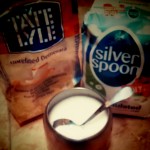 Nonalcoholic fatty liver is a condition characterised by lipid deposits in and around hepatic tissue. In this respect it shows similarity to alcoholic fatty liver which is caused by excessive long term alcohol intake. Fructose overconsumption is implicated in the development of nonalcoholic fatty liver because it is thought to overload the hepatic glycogen synthesis pathways and this results in uncontrolled de novo lipogenesis. The resulting fatty acids accumulate in liver tissue where they decrease insulin sensitivity and cause other metabolic abnormalities. In turn this leads to the development of abdominal obesity, lipoprotein dysfunction and blood sugar irregularities. These abnormalities characterise the metabolic syndrome, a disorder that increases the risk of developing cardiovascular disease and type 2 diabetes. The deleterious effects to both lipoprotein levels and blood glucose explains the association between these variables and cardiovascular disease, and provides a coherent aetiology for their development.
Nonalcoholic fatty liver is a condition characterised by lipid deposits in and around hepatic tissue. In this respect it shows similarity to alcoholic fatty liver which is caused by excessive long term alcohol intake. Fructose overconsumption is implicated in the development of nonalcoholic fatty liver because it is thought to overload the hepatic glycogen synthesis pathways and this results in uncontrolled de novo lipogenesis. The resulting fatty acids accumulate in liver tissue where they decrease insulin sensitivity and cause other metabolic abnormalities. In turn this leads to the development of abdominal obesity, lipoprotein dysfunction and blood sugar irregularities. These abnormalities characterise the metabolic syndrome, a disorder that increases the risk of developing cardiovascular disease and type 2 diabetes. The deleterious effects to both lipoprotein levels and blood glucose explains the association between these variables and cardiovascular disease, and provides a coherent aetiology for their development.
Starches do not cause nonalcoholic fatty liver because of the way the body regulates the de novo lipogenesis pathway. The de novo lipogenesis pathway is unusual in that while carbohydrate can be synthesised into fat, the reverse in not true. Many assume that energy from starches are unable to be stored as fat, but the de novo lipogenesis pathway will readily convert dietary carbohydrate to fatty acids. Once synthesised, fatty acids can be esterified to glycerol and packaged into the very low density lipoprotein particle (VLDL) for transport to peripheral tissues. The fate of much of this newly synthesised fat, under the control of insulin, is the adipose tissue where it is stored as triglycerides. Under normal conditions replacement of fat in the diet with starch does not change the balance of body fat, assuming reasonably energy intakes and whole grain starches, because regulatory mechanisms are put in place to increase carbohydrate oxidation. Likewise high intakes of fat will upregulate fatty acid oxidation and energy balance will be maintained.
For starch to be converted into fatty acids the glucose in plasma must first enter the liver cells where it passes down the glycolytic pathway before being converted to a molecules of acetyl CoA, and subsequently to malonyl CoA and then to fatty acids (figure 1). This conversion process is regulated tightly such that accumulation of acetyl CoA causes negative feedback to glycolysis and inhibits flux through the pathway. In this way de novo lipogenesis is rate limited. In addition starch is only slowly digested and so the delivery of the glucose to the liver is controlled. However, dietary fructose feeds into the glycolytic pathway at a later stage that glucose. This is significant because the point of entry to the pathway for fructose is after this main regulatory stage. High intakes of dietary fructose therefore increase acetyl CoA rapidly with little regulation and this overloads the ability of the liver to regulate de novo lipogenesis. The resulting unregulated fatty acids synthesis causes the deposition of fatty acids in the liver tissue itself.

Figure 1. Glucose flux through glycolysis is tightly regulated. However, fructose flux is not. This explains the reason that dietary fructose can overload the liver and cause metabolic damage, including the formation of nonalcoholic fatty liver.
Nonalcoholic fatty liver is only a recently discovered condition, and so relatively little is known about its aetiology. However, it is known that overtime the liver dysfunction associated with metabolic syndrome deteriorates into hepatic steatosis and then cirrhosis of the liver and eventual liver failure. In this regard the aetiology of nonalcoholic liver disease is similar to its alcoholic cousin. Some studies have investigated the specific changes to liver enzyme levels in those with characteristics of metabolic syndrome. For example in one study researchers investigated the relationship between aspartate aminotransferase (AST), alanine aminotransferase (ALT) and gamma-glutamyltransferase (GGT) and markers for metabolic syndrome1. The results showed that those subjects with metabolic syndrome were older as might be expected. In addition they had higher body mass indexes and higher liver values for AST, ALT and GGT, suggesting that liver function had been impaired.
Abnormal liver function in those with metabolic syndrome is not surprising given the aetiology of the disease. However, what is surprising is that the prevalence of metabolic syndrome in the subjects in this study was nearly 20 %. This is very high considering the subjects were recruited from healthy individuals undergoing routine health care screenings. Data like this sheds light on the reason for the high rates of obesity in developed nations. Further, the rates of metabolic syndrome were higher for men than women, which may explain the higher rates of cardiovascular disease in men compared to women. The presence of abnormal liver function explains many of the metabolic problems associated with metabolic syndrome, and also offers an explanation as to why such individuals find it hard to lose weight. The liver can use around 25 % of resting energy expenditure just processing food and undergoing normal metabolic regulation. A sluggish liver is reflected in a sluggish metabolism which can hinder weight loss efforts considerably.
